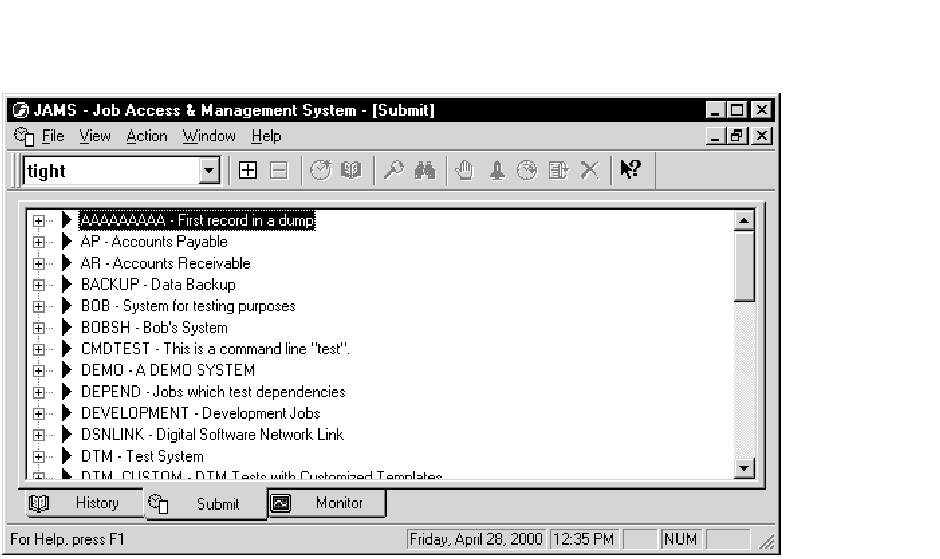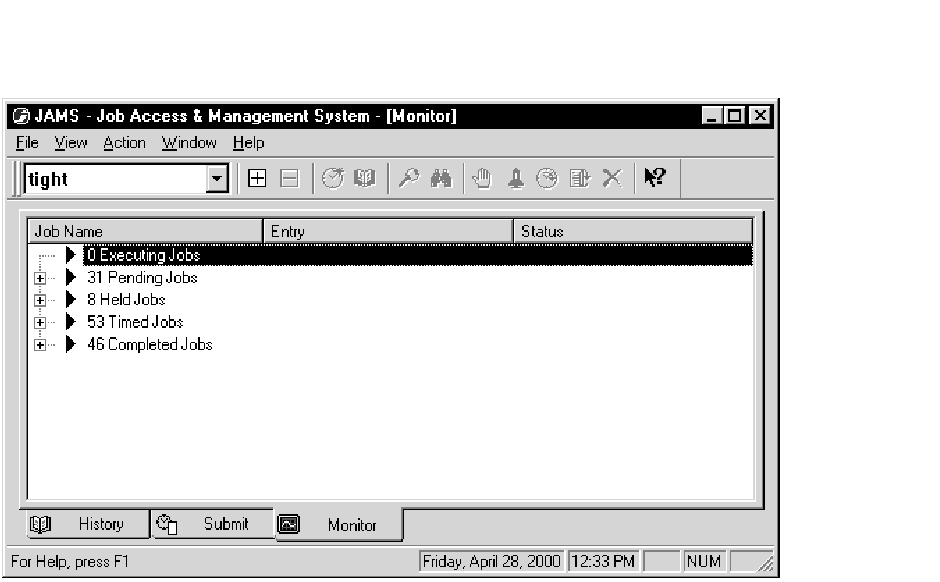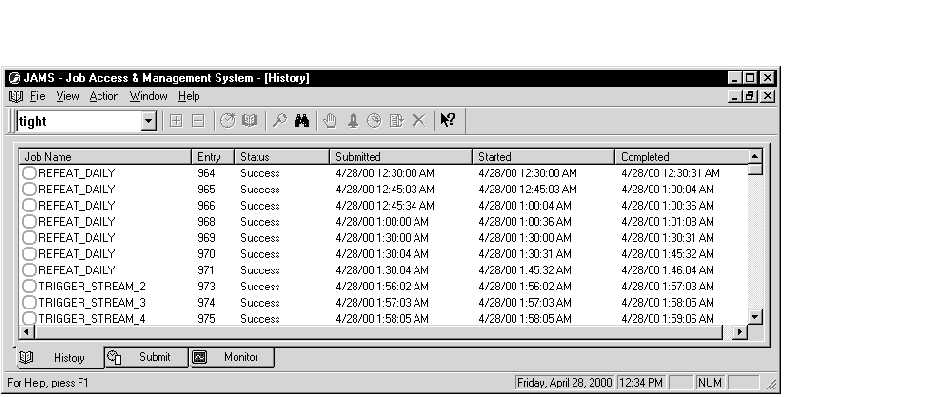
| Contents | Index | JAMS Home | Support |
 | ||||
|
| Previous | Contents | Index |
This chapter describes the JAMS Windows 9x/NT/2000 Interface.
You can submit, monitor, and view the history of job execution using
this interface.
7.1 Starting the JAMS Windows 9x/NT/2000 Interface
When JAMS is installed, JAMS is added to the Programs section of the Start Menu. To start the interface, select JAMS from the Programs section of the Start Menu.
If the JAMS menu item does not appear in your Start Menu, you can search for the file "JAMSWin.exe" on your local disk drives. If you find the file, double-click it to start the interface. You may also want to create a short-cut to this program to make it easily available for the future.
When JAMS starts, you will be presented with a JAMS
Server Login dialog box. Here you must specify the remote server you
would like to connect to along with your username and password for
authentication. At the time of login, you can also specify if you would
like for JAMS to remember this information the next time you
run the JAMS Windows interface.
7.2 Submit Window
The Submit Window is used to select and submit JAMS Jobs which are run on demand. The window consists of a default or user defined menu hierarchy. The default hierarchy shows all of the JAMS Systems, expanding a System displays all of the Jobs and Setups for the selected System.
If you want to specify a user defined menu, define the logical name JAMS_DEFAULT_MENU to be the name of the menu which you want to use as the top level menu.
Figure 7-1 is an example of the Submit Window.
Figure 7-1 Windows Submit Window

The Submit Window displays a menu hierarchy. A sub-menu is denoted with a triangle to the left of the menu name. If the triangle points to the right, the menu is not expanded. If the triangle points down, the menu is expanded. To expand a menu, you can double click on the menu or, click on the menu (to select it) and then pull down the Action menu and select Expand. You can also right-click while the cursor is on the menu you want to expand and then select Expand from the pop-up menu.
You can submit a Job or Setup by double clicking on the Job or Setup. You can also select Submit from the pull-down or pop-up menu.
You can activate the JAMS History window and display a Jobs
history by selecting Show History from a pull-down or
pop-up menu.
7.2.2 File menu
The File pull-down menu is used to control the Submit window.
This menu option activates a dialog box which allows you to connect to a remote JAMS Server. Once connected, you can submit Jobs on that server.
This menu option lets you disconnect from one of the remote JAMS Servers which you are connected to.
This menu option will close the Submit window.
This menu option will close all of the JAMS windows and exit.
7.2.3 Action menu
The Action menu is used to perform an action on the Submit window or the selected line in the Submit window. The items in the Action menu are also available from a pop-up menu. Right-click any menu, Job or Setup to display the pop-up menu. The options on the Action menu include:
This option will expand the selected line. This option is only active when the selected line is a menu line.
You can also expand or collapse a menu by double clicking on the menu line.
This option will collapse the selected menu line. This option is only active when the selected line is a menu line.
You can also expand or collapse a menu by double clicking on the menu line.
This option will collapse all expanded menus.
This option activates the JAMS History Window, clears the current history list and performs a search for history of the selected Job.
This option will submit the selected Job or Setup. A dialog box which
contains the jobs parameters will be displayed. If the Job has defined
reports, you can click on the Reports tab to display and possibly
override the report printing information.
7.2.4 Window menu
The Window menu is used to activate other portions of
the JAMS Windows interface. From the Submit window, you can
activate the History window or the Monitor window.
7.3 Submitting a Job
When you submit a job, a dialog box which contains the jobs parameters
will be displayed. If the Job has defined reports, you can click on the
Reports tab to display and possibly override the report printing
information.
7.4 Monitor Window
The Monitor Window is used to monitor and manage the batch jobs running on your system. The JAMS Job Monitor is a high performance, continuously updated display of the batch jobs known to JAMS. This display also provides comprehensive job management capabilities.
This monitor is a high performance batch job monitor. It does not scan the operating system's batch sub-system to obtain its information. The JAMS_SCHEDULE process broadcasts messages to the monitors when events occur. Running the JAMS monitor will not affect the performance of the batch sub-system. |
The Monitor Window includes two types of display lines, top level categories and Jobs. A top level category line includes an icon which shows whether or not the line is expanded, the number of jobs in the category, the name of the category and detail headings. You can expand or collapse a category line by double clicking on the line.
Figure 7-2 is an example of the Monitor Window.
Figure 7-2 Windows Monitor Window

When a Job is executing, the Monitor includes the following information:
This is the name of the job as specified in the JAMS Job definition.
This is the JAMS entry number for the job.
This is the name of the node on which this job is running.
This column shows the CPU utilization percentage for this job during the most recent update interval.
This column shows the average number of direct I/O's per second which this job performed during the most recent update interval.
If this job is registered in the JAMS database, we can compute the completion percent based on the Job's past performance. This percentage is an estimate of how close to completion the Job is. This can be a useful monitoring tool. If an operator sees a Job which shows a completion percentage of 200%, they know that the Job has used twice the resources which it normally takes and they may want to take corrective action.
This percentage is calculated using the Jobs current and average CPU usage and Direct I/O count so running the a Job on a heavily loaded system will not affect this calculation.
If this Job is registered in the JAMS database, we can calculate how much longer the Job is going to run based on the Job's past performance. This calculation is based on the Job's current CPU utilization and direct I/O per second count. We extrapolate this data to determine how much longer the job will run before reaching its average CPU usage and direct I/O count.
This shows how long the Job has been executing, in hours and minutes.
This shows how much CPU time the Job has accumulated, in hours and minutes.
This shows the number of direct I/O operations performed by the Job.
7.4.3 File menu
The File pull-down menu is used to control the Monitor window.
This menu option activates a dialog box which allows you to connect to a remote JAMS Server. Once connected, you can monitor Jobs on that server.
This menu option lets you disconnect from one of the remote JAMS Servers which you are connected to.
This menu option will close the Monitor window.
This menu option will close all of the JAMS windows and exit.
7.4.4 Action menu
The Action menu is used to perform an action on the Monitor window or the selected line in the Monitor window. The items in the Action menu are also available from a pop-up menu. Right-click a Job in the Monitor to display the pop-up menu. The options on the Action menu include:
This option will expand the selected line. All current and future jobs in this category will be displayed. This option is only active when the selected line is a top level line.
You can also expand or collapse a category by double clicking on the category line.
This option will collapse the selected line. The jobs in this category will no longer be displayed. This option is only active when the selected line is a top level line.
You can also expand or collapse a category by double clicking on the category line.
This option will collapse all of the top level categories.
You can also expand or collapse a category by double clicking on the category line.
This option will display a window which shows detailed information about the selected Job. This information will be updated as the Job executes.
You can also display a Job's detail window by double clicking on the Job.
This option activates the JAMS History Window, clears the current history list and performs a search for history of the selected Job.
Jobs can be in a pending or holding state for many different reasons. When you elect to release a job, a window will appear showing all the reasons this particular job is not running. You can then decide to remove some, or all of the constraints which are keeping the job from executing.
The selected job is held until released.
This option is used to change the scheduling attributes of a job which is still pending. A screen is displayed which allows you to enter a new queue name, scheduled date/time and hold status.
This option is used to abort and restart an executing job. A window is displayed which allows you to enter a new queue name and hold status. If you complete the form and click on the Ok button, the job is aborted and requeued.
If the selected job is currently executing, it is aborted and deleted
from the batch sub-system. Otherwise the job is simply deleted from the
batch sub-system. You are asked to confirm this action.
7.4.5 Window menu
The Window menu is used to activate other portions of
the JAMS Windows interface. From the Monitor window, you can
activate the Submit window, or the History window.
7.5 History Window
The History Window is used to search and examine batch job execution history.
Figure 7-3 is an example of the History Window.
Figure 7-3 Windows History Window

The History display window contains one line for each history record which matched your selection criteria. Each line shows the Job Name, final status and, submit, start and completion time. You can double click on a line to display a detail window.
You can sort the list by any column. To sort the list, single click on any column, JAMS will then sort the list in ascending order.
Each time you use the Search... option, the records
which match your selection criteria are added to the existing records.
You can clear the list by selecting Clear List from
the Action menu.
7.5.2 File menu
The File pull-down menu is used to control the History window.
This menu option activates a dialog box which allows you to connect to a remote JAMS Server. Once connected, you can search History on that server.
This menu option lets you disconnect from one of the remote JAMS Servers which you are connected to.
This menu option will close the History window.
This menu option will close all of the JAMS windows and exit.
7.5.3 Action menu
The Action menu is used to perform an action on the History window or the selected line in the History window. The options on the Action menu include:
This option will display a window which shows detailed information about the selected Job. From this detail window, you can also view the Jobs log file.
You can also display a Jobs detail window by double clicking on the Job.
This option displays a dialog box in which you enter your selection criteria. When you click on the Ok button, the search starts and a work in progress box is displayed. The work in progress box has a Cancel button which can be used to cancel a long search. If you cancel a search, all of the records located thus far will be included in the list.
The number of records which a single search will add to the list can be limited. Define the logical name JAMS_HISTORY_LIMIT to be the desired limit. If this logical name is not defined, the limit defaults to 500 records.
Each time you use the Search... option, the records which match your selection criteria are added to the existing records. You can clear the list by selecting Clear List from the Action menu.
This option clears all of the history lines from the list. Each time
you perform a search, the lines which match the search are added to the
current list.
7.5.4 Window menu
The Window menu is used to activate other portions of
the JAMS Windows interface. From the History window, you can
activate the Submit window, or the Monitor window.
7.5.5 History Search Window
The Search window is displayed to obtain search selection criteria. You can enter:
Here you can select the Remote Node which is where the search will actually occur on.
Enter a System ID to limit the history records to Jobs from the specified System. Leave this field blank to display Jobs from any System.
Enter Job Name with wildcards. The wildcard characters are * which matches any set of characters and % which matches any single character.
Enter Setup Name with wildcards. The wildcard characters are * which matches any set of characters and % which matches any single character.
Enter the beginning and ending date and time range. Only Jobs submitted within this range will be included in the list.
You can limit your search to only Jobs with a specific final status
severity. Select the severities which you want to include in your list.
7.6 Using Help
There are three ways to obtain help from within the JAMS Windows interface:
The Help menu has two options. If you select Help Topics option, a JAMS Client help application appears.
The About JamsWin option displays the standard windows about box, showing copyright and version information.
By selecting the Toolbar Help option you will find that the cursor changes to a question mark and you can click on the component of the window on which you would like help.
If you press the [Help F1] key, JAMS will provide help on the item in which the cursor is located. If this item does not have any specific help, help will be displayed on the next higher item (such as the window which contains the item).
Some dialog boxes have a Help button which will provide help which is specific to the dialog box. In some cases, a dialog box will have a Help button but it will not be active. This means that the dialog box is capable of providing help but there is no help available for the specific message being displayed by the dialog box.
| Previous | Next | Contents | Index |
| Copyright © 2000, MVP Systems, Inc. All rights reserved. |